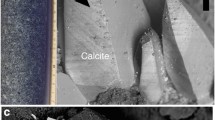Abstract
Two different and physically separated chemosynthetic communities of bacteria are responsible for the formation of the Beeri native sulfur deposit hosted in a Late Quaternary sandstone on the southern coastal plain of Israel. The enriched concentrations are distributed over an area of about 1 km2, within a zone 2–3 m thick at 1–13 m below surface. Two hundred fifty meters below the sulfur deposit, sulfur-reducing bacteria, thriving on methane generated in Neogene marls, reduced the Messinian gypsum to generate hydrogen sulfide, which subaqueously vented together with methane into the siliciclastic Quaternary sequence. Another, different chemosynthetic community ofBeggiatoa-like and unidentified bacteria oxidized the hydrogen sulfide into native sulfur and secondary gypsum, alunite, and iron sulfates. The coupled chemical and bacterial processes attributed to the formation of the sulfur deposit at Beeri are strikingly similar to the processes occurring today in the context of submarine hydrocarbon vents associated with the salt diapirs in the Gulf of Mexico.
Similar content being viewed by others
References
Aharon P and Chappell J (1986) Oxygen isotopes, sea level changes and the temperature history of a coral reef environment in New Guinea over the last 105 years. Palaeogeography Palaeoclimatology Palaeoecology 5:337–379
Blanckenhorn M (1930) Das Schwefelvorkommen sudlich von Gaza. Praktische Geologie 335:183
Buchbinder B (1975) Lithogenesis of Miocene reef limestones in Israel with particular reference to the significance of the red algae. Geological Survey of Israel Report OD/33/75 173 pp
Buchbinder B, Martinotti GM, Siman Tov R, and Zilberman E (1993) Temporal and spatial relationships in Miocene carbonates in Israel. Palaeogeography Palaeoclimatology Palaeoecology 101:97–116
Druckman Y, Buchbinder B, Martinotti GM, and Siman Tov R (1992) The Afiq Channel—a submarine canyon with a large scale slide—scar at its outlet. Israel Geological Society, Annual Meeting Abstracts pp 32–33
Ehrlich HL (1990) Geomicrobiology, 2nd ed. New York: Marcel Dekker 646 pp
Goldberg M (1982) The Beeri 3 borehole—results of hydrocarbon gases from the interval 360–1075 m. Geological Survey of Israel Report 4 pp
Goldhaber MB and Kaplan IR (1974) The sulfur cycle. In: Goldberg ED (Ed.), The Sea. New York: Wiley pp 569–656
Gvirtzman G (1969) Subsurface data on the Saqiye Group in the coastal plain and Hashephela regions, Israel. Geological Survey of Israel Report OD/1/69, n.p.
Gvirtzman G (1970) The Saqiye Group (Late Eocene to Early Pleistocene) in the Coastal Plain and Hashephela regions, Israel. Geological Survey of Israel Report OD/5/67 170 pp
Gvirtzman G, Shachnai E, Bakler N, and Ilani S (1984) Stratigraphy of the Kurkar Group (Quaternary) of the coastal plain of Israel. Geological Survey of Israel Current Research 1983/1984 pp 70–82
Hill CA (1990) Sulfuric acid speleogenesis of Carlsbad Cavern and its relationship to hydrocarbons, Delaware Basin, New Mexico and Texas. American Association of Petroleum Geologists Bulletin 74:1685–1694
Horowitz A (1979) The Quaternary of Israel. New York: Academic Press 394 pp
Ivanov MV (1968) Microbiological Processes in the Formation of Sulfur Deposits. Israel Program for Scientific Translations. Washington DC: US Department of Agriculture and National Science Foundation 298 pp
Larkin J, Aharon P, and Henk MC (1994)Beggiatoa in microbial mats at hydrocarbon vents in the Gulf of Mexico and Warm Mineral Springs, Florida. Geo-Marine Letters 14:97–103
Longinelli A (1980) Isotope geochemestry of some Messinian evaporites: Paleoenvironmental implications. Palaeogeography Palaeoclimatology Palaeoecology 29:95–123
Nielsen H (1978) Sulfur isotopes in nature. In: Wedephol J (Ed.), Handbook of Geochemistry. Heidelberg: Springer pp B1-B40
Nissenbaum A (1984) Methane derived organic matter and carbonates. Organic Geochemistry 5:187–192
Nissenbaum A and Kaplan IR (1966) Origin of the Beeri (Israel) sulfur deposit. Chemical Geology 1:295–316
Panganiban AT Jr, Patt TE, Hart W, and Hanson S (1979) Oxidation of methane in the absence of oxygen in lake water samples. Applied Environmental Microbiology 37:303–309
Pomerancblum M, Neev D, and Reiss Z (1962) Sedimentological analysis of “Sakiebeds” in Beeri core-hole No. 1 (sulfur). Geological Survey of Israel Report Rec/1/62 39 pp
Postgate JR (1984) The Sulfate Reducing Bacteria, 2nd ed. Cambridge: Cambridge University Press 208 pp
Picard L (1930) Rapport einer Untersuchung der Schwefellagerstatten bei Gaza. Palestine Mining Syndicate Report 14 pp
Sneh A (1983) Redeposited loess from the Quaternary Besor Basin, Israel. Israel Journal of Earth Sciences 32:63–70
Tschop HJ and Wiener G (1958) The occurrence of gas in the BeeriSa'ad area (southern coastal plain of Israel). Bulletin Verein Schweizer Petroleum Geologen und Ingenieuren 24:27–32
Walker RW (1957) Beeri SH-6 well report. Lapidot Memo 4 pp
Author information
Authors and Affiliations
Rights and permissions
About this article
Cite this article
Druckman, Y., Weissbrod, T. & Aharon, P. Evidence for methane and hydrogen sulfide venting imprinted on a Quaternary eolianite from southern Israel. Geo-Marine Letters 14, 170–176 (1994). https://doi.org/10.1007/BF01203728
Received:
Revised:
Issue Date:
DOI: https://doi.org/10.1007/BF01203728




